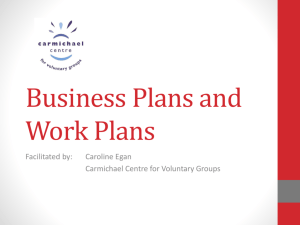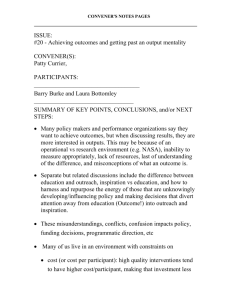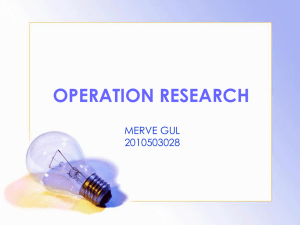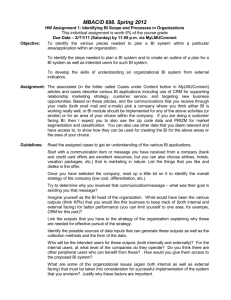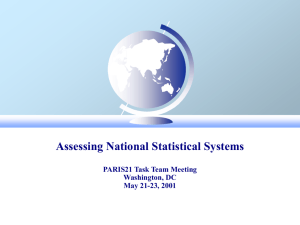Components of a logic model
advertisement
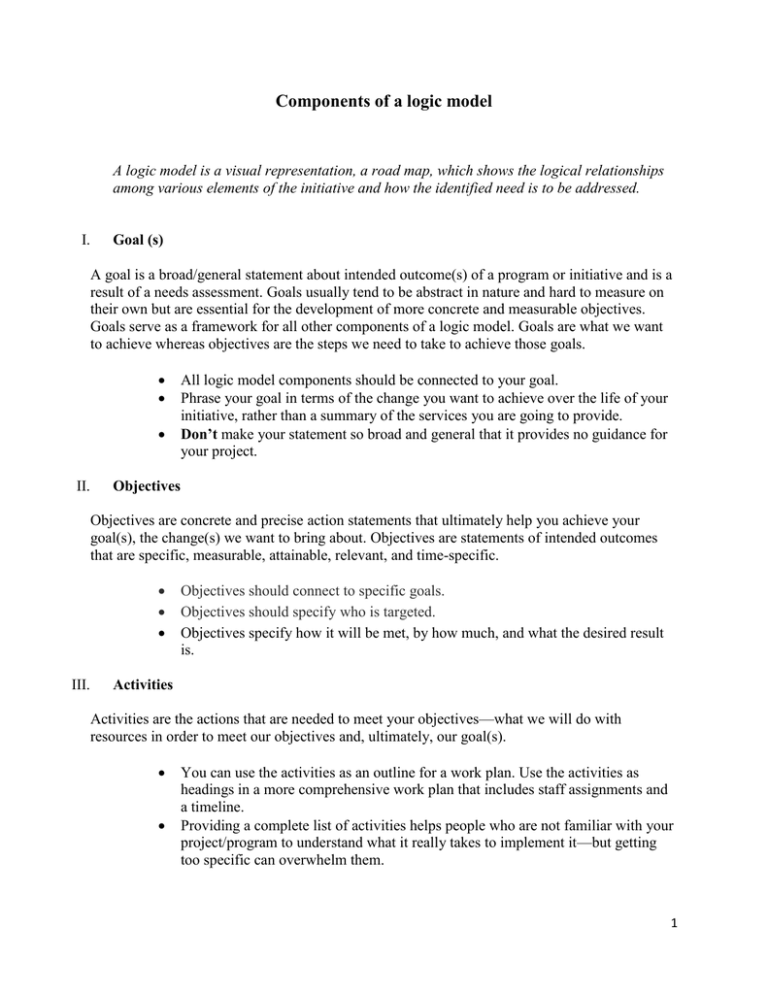
Components of a logic model A logic model is a visual representation, a road map, which shows the logical relationships among various elements of the initiative and how the identified need is to be addressed. I. Goal (s) A goal is a broad/general statement about intended outcome(s) of a program or initiative and is a result of a needs assessment. Goals usually tend to be abstract in nature and hard to measure on their own but are essential for the development of more concrete and measurable objectives. Goals serve as a framework for all other components of a logic model. Goals are what we want to achieve whereas objectives are the steps we need to take to achieve those goals. II. All logic model components should be connected to your goal. Phrase your goal in terms of the change you want to achieve over the life of your initiative, rather than a summary of the services you are going to provide. Don’t make your statement so broad and general that it provides no guidance for your project. Objectives Objectives are concrete and precise action statements that ultimately help you achieve your goal(s), the change(s) we want to bring about. Objectives are statements of intended outcomes that are specific, measurable, attainable, relevant, and time-specific. III. Objectives should connect to specific goals. Objectives should specify who is targeted. Objectives specify how it will be met, by how much, and what the desired result is. Activities Activities are the actions that are needed to meet your objectives—what we will do with resources in order to meet our objectives and, ultimately, our goal(s). You can use the activities as an outline for a work plan. Use the activities as headings in a more comprehensive work plan that includes staff assignments and a timeline. Providing a complete list of activities helps people who are not familiar with your project/program to understand what it really takes to implement it—but getting too specific can overwhelm them. 1 IV. Input/Resources Identify resources needed for activities in order to meet objectives. This helps determine the extent to which the initiative can be implement and desired outcome can be achieve. A list of resources can also be used to develop a budget for the initiative. V. Human resources: Personnel with sufficient abilities and skills to implement activities. Financial resources: Money needed to cover the cost of activities. Space: Facilities needed for activities (e.g., facility for professional development sessions). Technology/equipment: Any technology and/or equipment required in order to undertake activities (e.g., computer hardware, software, printers, and copiers). Materials/Other: Supplies or materials needed for activities (e.g., office supplies, training materials). Outputs Outputs are the tangible and direct results of activities. While they help us evaluate how well we are implementing the initiatives, they are not the changes we expect the initiatives to achieve. They should, however, ultimately lead to desired outcomes. “An output statement doesn’t reveal anything about quality.” You will assess the quality of your outputs in your evaluation. VI. Outputs should be linked to specific activities and resources. Express outputs in terms of volume or units of services delivered or produced by activities. For example: o Number of students tutored and hours of tutoring service provided. o Number of professional development sessions conducted, topics covered, and number of school staff trained. o Action plans developed. o Number of leadership team meetings. Outcomes Outcome statements express the result(s) that our initiative intends to achieve if implemented as planned. Outcomes are specific, attainable and measurable changes that we hope will take place as a result of our initiative. It answers the question, “what difference did our initiative make?” We should be able to measure the desired change at individual, group or organizational level by measuring changes in knowledge, behavior, and/or condition. Short-term Outcomes: What change do you expect to occur either immediately or in the near future? Short-term outcomes are those that are the most direct result of activities and outputs. They are typically not ends in themselves, but are necessary steps toward desired ends (intermediate or long-term outcomes or goals) 2 VII. Intermediate Outcomes: What change do you want to occur after that? Intermediate outcomes are those outcomes that link initiative’s short-term outcomes to long-term outcomes. Long-term Outcome: What change do you hope will occur and be sustained over time? Long-term outcomes are those that result from the achievement of your short- and intermediate-term outcomes. They are also generally outcomes over which your program has a less direct influence. Often long-term outcomes will occur beyond the timeframe you identified for your logic model. Indicator/Data source Indicators tell us when/if changes have occurred. When we develop our objectives we need to ask ourselves the following questions. How will we know when we have achieved our objectives? What indicators will we look for to measure the progress and success of our initiative? Are data to measure our progress and/or success readily available or do we need to develop new measures, e.g., surveys, focus groups, etc…? Logic Model Review Once our logic model is complete, let’s take time to revisit and review our work and consider the following questions: Does our county/school have adequate resources to implement the activities and achieve the desired outcomes? If you need further resources, is that reflected in your activities? Have we included all the major activities needed to implement our program and achieve expected outcomes? Would the activities list enable someone who is unfamiliar with our program to understand its scope? Have we expressed our outcomes in terms of change? Have we identified who/what will experience that change, and over what time period? Do activities, outputs, and short- and long-term outcomes relate to each other logically (the “if-then” relationship), and collectively do they relate to the corresponding objective and the overall goal? Does our logic model clearly identify the scope of our initiative’s influence? 3
